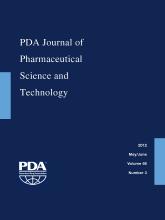Abstract
Endotoxin indicators (EIs) and photometric bacterial endotoxin test (BET) assays were used to determine the capacity of alumina (Al2O3) for removing endotoxin from a parenteral solution. Fludeoxyglucose F 18 (FDG) Injection, USP, a radioactive imaging agent, is made daily at about 150 American sites for same-day administration. Each FDG synthesis unit contains a cartridge of alumina for removing a radiochemical impurity before delivery to the final product vial. Recognizing that alumina is a cationic adsorption medium, its capacity for removing endotoxin was challenged with purified endotoxin. A 2000 EU vial of an EI was reconstituted with water or FDG, vortex-mixed, and passed through a representative final product assembly consisting of an alumina cartridge with connecting tubing, a sterilizing membrane filter, and aseptic collection vial. In addition to sterilization, the filter removed alumina “fines” that are inhibitory to the BET because of adsorption of the positive control. Confirmation of labeled claim for each EI and measurement of endotoxin challenge eluates from a simulated FDG process were analyzed by valid kinetic chromogenic assays using a microplate reader and a cartridge reader. Overkill depyrogenation conditions were achieved, defined as greater than a 3 log endotoxin reduction. In conclusion, alumina was observed to depyrogenate the eluate of a representative FDG synthesis unit.
LAY ABSTRACT: A fever-inducing (pyrogenic) bacterial toxin may arise during the complex synthesis of a radioactive imaging agent known as Fludeoxyglucose F 18 (FDG) Injection. One of the purification steps for FDG, a cartridge of aluminum oxide (alumina), removes negatively charged, radioactive impurities. Representative FDG solutions were inoculated with purified bacterial endotoxin to determine if the toxin's negative charge would result in removal by alumina. Alumina's effectiveness for endotoxin removal, a process known as depyrogenation, was measured by endotoxin detection assays. Alumina reduced endotoxin levels by more than a thousand fold in a simulated FDG process. Therefore, an unrecognized benefit of the alumina cartridge is removal of a potentially harmful toxin while purifying the FDG for patient injection.
- Endotoxin
- Depyrogenation
- Alumina
- Fludeoxyglucose
- Endotoxin indicators
- Endotoxin reduction
- Photometric bacterial endotoxins test
- LAL cartridge
- © PDA, Inc. 2012
PDA members receive access to all articles published in the current year and previous volume year. Institutional subscribers received access to all content. Log in below to receive access to this article if you are either of these.
If you are neither or you are a PDA member trying to access an article outside of your membership license, then you must purchase access to this article (below). If you do not have a username or password for JPST, you will be required to create an account prior to purchasing.
Full issue PDFs are for PDA members only.
Note to pda.org users
The PDA and PDA bookstore websites (www.pda.org and www.pda.org/bookstore) are separate websites from the PDA JPST website. When you first join PDA, your initial UserID and Password are sent to HighWirePress to create your PDA JPST account. Subsequent UserrID and Password changes required at the PDA websites will not pass on to PDA JPST and vice versa. If you forget your PDA JPST UserID and/or Password, you can request help to retrieve UserID and reset Password below.






